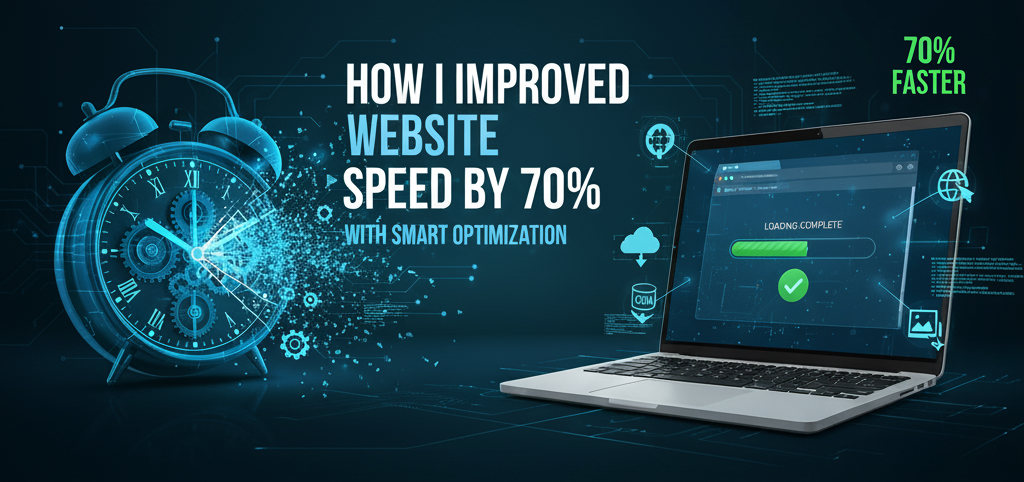How I Improved Website Speed by 70% with Smart Optimization

Introduction
In today’s digital-first world, a slow website doesn’t just frustrate users-it costs businesses money. Research shows that even a 1-second delay in page load time can reduce conversions by 7%. For a business that relies on its website to generate leads or sales, that’s a huge loss.
In this case study, I’ll walk you through how I helped one client improve their website speed by 70% with smart, targeted optimization techniques. You’ll see the exact problems they faced, the approach I used, and the results they achieved.
The Problem: A Beautiful Website That Wasn’t Performing
My client, a mid-sized e-commerce business, had invested in a beautifully designed website. On the surface, everything looked great - modern design, attractive visuals, and a strong product catalog.
But there was one major issue: the site was painfully slow.
- Pages were taking 8–10 seconds to load.
- Customers often abandoned the site before making a purchase.
- SEO rankings were suffering due to poor Core Web Vitals.
- The client was losing both traffic and revenue.
They had tried basic fixes like upgrading hosting, but the problem persisted. That’s when they reached out to me.
The Approach: Smart, Layered Optimization
Instead of just applying a “one-size-fits-all” solution, I took a layered approach to optimization. The goal was to identify what was really slowing the site down and fix those bottlenecks one by one.
Here’s how I approached it:
1. Performance Audit
I started with a comprehensive speed audit using tools like Google PageSpeed Insights, GTmetrix, and Lighthouse.
This gave me a clear picture of:
- Large image files that weren’t compressed
- Unused JavaScript and CSS slowing down render time
- A lack of caching strategy
- Render-blocking resources
2. Image Optimization
The site used high-quality product images, but most were uncompressed and oversized.
- I applied lossless compression and converted images to next-gen formats (WebP).
- Implemented lazy loading so images loaded only when visible on the screen.
3. Code & Asset Optimization
The site had multiple CSS and JS files loading unnecessarily.
- I minified CSS/JS and combined files where possible.
- Removed unused libraries and scripts.
- Deferred non-essential scripts so they loaded after the main content.
4. Caching & CDN Setup
The client’s hosting plan didn’t use caching effectively.
- I set up server-side caching.
- Integrated a Content Delivery Network (CDN) to serve assets faster worldwide.
5. Server & Database Optimization
Finally, I worked on the backend.
- Optimized the MySQL database by removing unused entries.
- Upgraded to PHP 8+, which improved server response times.
The Solution in Action
These optimizations weren’t just theoretical-they delivered real results. After implementing changes, I tested the site again:
- Page load time: Reduced from 8–10 seconds to just 2.5 seconds.
- Google PageSpeed score: Jumped from 42 to 92 (mobile) and 98 (desktop).
- Bounce rate: Dropped by nearly 40%.
- Sales conversions: Increased by 18% within the first month.
The client was amazed not just by the numbers but by the visible difference in how smooth the site felt.
The Result: Business Growth Through Better User Experience
This project proved once again that website speed is not just a technical factor-it’s a business driver.
By improving performance, the client gained:
- Higher customer satisfaction
- Improved SEO rankings (more organic traffic)
- Increased sales and revenue
- A faster, more reliable platform to scale their business
For them, it wasn’t about “technical tweaks.” It was about creating a faster, more trustworthy experience that customers love.
Key Takeaways for Businesses
- A slow website can silently eat away at your profits.
- Smart optimization isn’t just about upgrading hosting - it’s about tackling the real bottlenecks.
- Even small changes, like image compression or caching, can create a big impact.
- The end goal is not just speed-it’s better user experience and higher conversions.
Final Thoughts
Website optimization is not a one-time activity - it’s an ongoing process. By focusing on images, scripts, caching, database health, and hosting, I was able to deliver a 70% speed boost that directly impacted business results.
If your website feels sluggish or your customers are leaving before the page loads, these same techniques can help you.
Call to Action
Want me to analyze and optimize your website for speed? I specialize in helping small businesses get faster, more reliable websites that convert better.
Let’s talk about speeding up your site.
